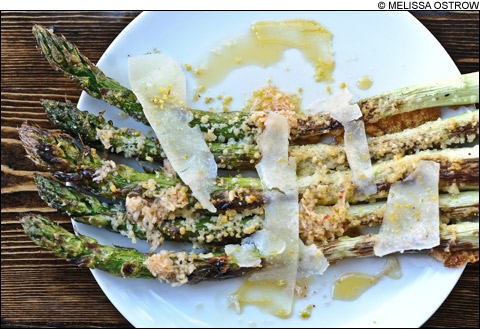
FORNO-GRAPHIC Asparagus al forno features giant wood-roasted pieces of asparagus, elegantly peeled, but wildly flavored with horseradish and pecorino. |
| Coppa | 253 Shawmut Avenue, Boston | 617.391.0902 | Open Monday–Friday, Noon–4 pm and 5:30 pm–12:45 am; Saturday, 5:30 pm–12:45 am; and Sunday, 11 am–3 pm and 5:30 pm–12:45 am | AE, MC, VI | Beer, wine, cordials | No valet parking | Access to all indoor tables up one large step |
One of the strange features of the Great Recession is the incredible complexity of down-market maneuvers. Here we have an Italian restaurant with plenty of outdoor tables but fewer than 40 seats when it rains. It took six months of planning to come to fruition, and now credits three chefs and two managers, but has only one dessert. If the owners planned for a year and had six chefs and four managers, would they be able to offer two sweet things?You can imagine some of Coppa’s origin process by getting to know the principal players: Ken Oringer and Jamie Bissonnette. Oringer has six restaurants, most of which run toward small plates of intensely flavored food. One of his restaurants is named Uni, Japanese for sea urchin roe. Another is called Toro, which is at least a pun on the Japanese word for raw tuna belly. (Almost all of his restaurants feature sea-urchin roe and raw tuna belly.) Coppa has both foods, but its name doesn’t mean anything in Japanese. It can be translated as “cup” in Italian, as in coppa di gelato — the one dessert offered. Bissonnette, who also holds chef-owner credits at Toro, is Coppa’s Spanish counterpart in the way of small plates and lines out the door.
Though the menu is rather complicated, Coppa’s pricing is deceptively simple: all bar snacks are $5, vegetable $6, charcuterie/salumi and cold small plates $9, hot small plates $12, pasta dishes $13, and wood-fired pizzas $15.
Of the stuzzichini (snacks), meatballs al forno ($5) is one of the great meat dishes in Boston. Given these chefs’ membership in the whole-carcass club, you might expect some spare parts for enrichment, but the secret ingredient seems to be just a little lardo (aged, flavored, lard). It’s one of the top tomato sauces anywhere. If they put this on pasta, that would be all anyone except vegetarians would need. Arancini ($5) are only two lacrosse balls’ worth of fried risotto, but crisp outside, soft and creamy with fontina cheese.
Since the owners are deep into house-made charcuterie, you must have something off the nine-deep salumi list. (There is usually an off-menu sampler of three things for $21.) I ordered basic mortadella, the original Bologna sausage, just to see what a $9 plate of baloney would look like. It was thin-sliced (the machine is so recherché there’s a picture of it on the restaurant’s Facebook page) and crumpled up a little bit, sprinkled with olive oil and served on a small plate. Their mortadella is certainly as good as any I’ve had in Italy.
A special appetizer our day was a crudo (implies sashimi, but I think they cooked them) of razor clams ($8) in thin strips with walnuts and yuzu aioli. The contrast of textures was fascinating, and the citron-garlic mayo addictive, but none of it was very filling.